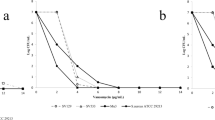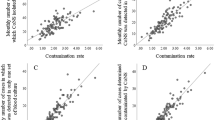Abstract
The aim was to prospectively describe the colonization pattern of coagulase-negative staphylococci (CoNS) and the relationship between colonizing and invasive CoNS isolates among patients undergoing treatment for hematological malignancy. Fourteen newly diagnosed patients were included with either multiple myeloma or acute leukemia. Patients were repeatedly sampled from nares, throat, axillae, and perineum, and the CoNS isolates obtained were phenotypically characterized together with blood isolates of CoNS using the PhenePlate system (PhP). During the treatment a gradual reduction in the heterogeneity of colonizing CoNS was observed as well as an inter-patient accumulation of phenotypically related and multi-drug-resistant CoNS. These clusters of CoNS persisted for 2–3 months after the end of therapy. Ten positive blood cultures of CoNS were obtained and in the majority of these cases CoNS of the same PhP type were found in superficial cultures collected prior to the blood culture sampling. In conclusion, the study shows that therapy for hematological malignancy is associated with a homogenization of colonizing CoNS isolates and that this acquired flora of CoNS is persistent several months after the end of therapy. Furthermore, the results suggest that the source of bloodstream infections of CoNS in hematological patients is colonizing CoNS of the skin and mucosa.




Similar content being viewed by others
References
Roth RR, James WD (1988) Microbial ecology of the skin. Annu Rev Microbiol 42:441–464
Kloos WE, Musselwhite MS (1975) Distribution and persistence of Staphylococcus and Micrococcus species and other aerobic bacteria on human skin. Appl Microbiol 30(3):381–385
Knauer A, Fladerer P, Strempfl C, Krause R, Wenisch C (2004) Effect of hospitalization and antimicrobial therapy on antimicrobial resistance of colonizing Staphylococcus epidermidis. Wien Klin Wochenschr 116(14):489–494
Larson EL, McGinley KJ, Foglia AR, Talbot GH, Leyden JJ (1986) Composition and antimicrobic resistance of skin flora in hospitalized and healthy adults. J Clin Microbiol 23(3):604–608
Archer GL (1991) Alteration of cutaneous staphylococcal flora as a consequence of antimicrobial prophylaxis. Rev Infect Dis 13 [Suppl 10]:S805–S809
Nouwen JL, van Belkum A, de Marie S, Sluijs J, Wielenga JJ, Kluytmans JA, Verbrugh HA (1998) Clonal expansion of Staphylococcus epidermidis strains causing Hickman catheter-related infections in a hemato-oncologic department. J Clin Microbiol 36(9):2696–2702
Burnie JP, Naderi-Nasab M, Loudon KW, Matthews RC (1997) An epidemiological study of blood culture isolates of coagulase-negative staphylococci demonstrating hospital-acquired infection. J Clin Microbiol 35(7):1746–1750
Blum-Menezes D, Bratfich OJ, Padoveze MC, Moretti ML (2009) Hospital strain colonization by Staphylococcus epidermidis. Braz J Med Biol Res 42(3):294–298
Rogers KL, Fey PD, Rupp ME (2009) Coagulase-negative staphylococcal infections. Infect Dis Clin North Am 23(1):73–98
Cherif H, Kronvall G, Bjorkholm M, Kalin M (2003) Bacteraemia in hospitalised patients with malignant blood disorders: a retrospective study of causative agents and their resistance profiles during a 14-year period without antibacterial prophylaxis. Hematol J 4(6):420–426
O’Gara JP, Humphreys H (2001) Staphylococcus epidermidis biofilms: importance and implications. J Med Microbiol 50(7):582–587
Costa SF, Barone AA, Miceli MH, van der Heijden IM, Soares RE, Levin AS, Anaissie EJ (2006) Colonization and molecular epidemiology of coagulase-negative Staphylococcal bacteremia in cancer patients: a pilot study. Am J Infect Control 34(1):36–40
Costa SF, Miceli MH, Anaissie EJ (2004) Mucosa or skin as source of coagulase-negative staphylococcal bacteraemia? Lancet Infect Dis 4(5):278–286
Kennedy HF, Morrison D, Kaufmann ME, Jackson MS, Bagg J, Gibson BE, Gemmell CG, Michie JR (2000) Origins of Staphylococcus epidermidis and Streptococcus oralis causing bacteraemia in a bone marrow transplant patient. J Med Microbiol 49(4):367–370
Mermel LA (2007) Prevention of central venous catheter-related infections: what works other than impregnated or coated catheters? J Hosp Infect 65 [Suppl 2]:30–33
Herwaldt LA, Hollis RJ, Boyken LD, Pfaller MA (1992) Molecular epidemiology of coagulase-negative staphylococci isolated from immunocompromised patients. Infect Control Hosp Epidemiol 13(2):86–92
Spare MK, Tebbs SE, Lang S, Lambert PA, Worthington T, Lipkin GW, Elliott TS (2003) Genotypic and phenotypic properties of coagulase-negative staphylococci causing dialysis catheter-related sepsis. J Hosp Infect 54(4):272–278
Nilsdotter-Augustinsson A, Koskela A, Ohman L, Soderquist B (2007) Characterization of coagulase-negative staphylococci isolated from patients with infected hip prostheses: use of phenotypic and genotypic analyses, including tests for the presence of the ica operon. Eur J Clin Microbiol Infect Dis 26(4):255–265
Bjorkqvist M, Liljedahl M, Zimmermann J, Schollin J, Soderquist B (2010) Colonization pattern of coagulase-negative staphylococci in preterm neonates and the relation to bacteremia. Eur J Clin Microbiol Infect Dis 29(9):1085–1093
Persson L, Strid H, Tidefelt U, Soderquist B (2006) Phenotypic and genotypic characterization of coagulase-negative staphylococci isolated in blood cultures from patients with haematological malignancies. Eur J Clin Microbiol Infect Dis 25(5):299–309
Jung K, Brauner A, Kuhn I, Ransjo U, Hylander B, Flock JI, Mollby R (1995) Typing of coagulase-negative staphylococci from peritonitis in CAPD-patients by the PhP-CS system and REA. APMIS 103(9):679–685
Wisplinghoff H, Seifert H, Wenzel RP, Edmond MB (2003) Current trends in the epidemiology of nosocomial bloodstream infections in patients with hematological malignancies and solid neoplasms in hospitals in the United States. Clin Infect Dis 36(9):1103–1110
Van Belkum A, Kluijtmans J, van Leeuwen W, Goessens W, ter Averst E, Wielenga J, Verbrugh H (1996) Monitoring persistence of coagulase-negative staphylococci in a hematology department using phenotypic and genotypic strategies. Infect Control Hosp Epidemiol 17(10):660–667
Ansaruzzaman M, Bhuiyan NA, Begum YA, Kuhn I, Nair GB, Sack DA, Svennerholm AM, Qadri F (2007) Characterization of enterotoxigenic Escherichia coli from diarrhoeal patients in Bangladesh using phenotyping and genetic profiling. J Med Microbiol 56(Pt 2):217–222
Brown E, Wenzel RP, Hendley JO (1989) Exploration of the microbial anatomy of normal human skin by using plasmid profiles of coagulase-negative staphylococci: search for the reservoir of resident skin flora. J Infect Dis 160(4):644–650
Muldrew KL, Tang YW, Li H, Stratton CW (2008) Clonal dissemination of Staphylococcus epidermidis in an oncology ward. J Clin Microbiol 46(10):3391–3396
Archer GL, Armstrong BC (1983) Alteration of staphylococcal flora in cardiac surgery patients receiving antibiotic prophylaxis. J Infect Dis 147(4):642–649
Hira V, Sluijter M, Goessens WH, Ott A, de Groot R, Hermans PW, Kornelisse RF (2010) Coagulase-negative staphylococcal skin carriage among neonatal intensive care unit personnel: from population to infection. J Clin Microbiol 48(11):3876–3881
Milisavljevic V, Wu F, Cimmotti J, Haas J, Della-Latta P, Larson E, Saiman L (2005) Genetic relatedness of Staphylococcus epidermidis from infected infants and staff in the neonatal intensive care unit. Am J Infect Control 33(6):341–347
Acknowledgments
We wish to thank Birgitta Sjöberg, Anna Önnberg, and Lena Barkman for skillful technical assistance.
Transparency declaration
The study was supported by grants from the research committee of Örebro County Council, Sweden. Bo Söderquist has been a consultant for Pfizer and Janssen-Cilag.
Author information
Authors and Affiliations
Corresponding author
Rights and permissions
About this article
Cite this article
Ahlstrand, E., Persson, L., Tidefelt, U. et al. Alteration of the colonization pattern of coagulase-negative staphylococci in patients undergoing treatment for hematological malignancy. Eur J Clin Microbiol Infect Dis 31, 1679–1687 (2012). https://doi.org/10.1007/s10096-011-1493-6
Received:
Accepted:
Published:
Issue Date:
DOI: https://doi.org/10.1007/s10096-011-1493-6




